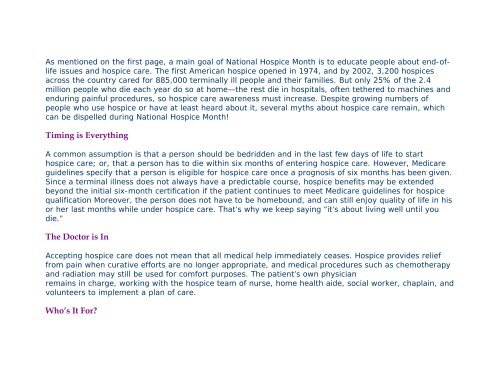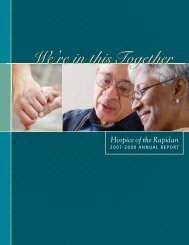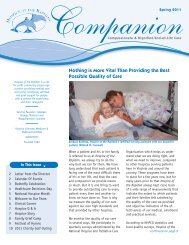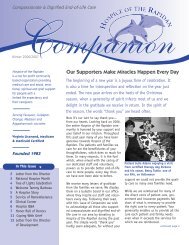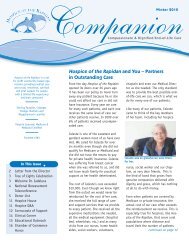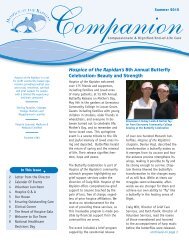Fall 2003 - Hospice of the Rapidan
Fall 2003 - Hospice of the Rapidan
Fall 2003 - Hospice of the Rapidan
You also want an ePaper? Increase the reach of your titles
YUMPU automatically turns print PDFs into web optimized ePapers that Google loves.
As mentioned on <strong>the</strong> first page, a main goal <strong>of</strong> National <strong>Hospice</strong> Month is to educate people about end-<strong>of</strong>life<br />
issues and hospice care. The first American hospice opened in 1974, and by 2002, 3,200 hospices<br />
across <strong>the</strong> country cared for 885,000 terminally ill people and <strong>the</strong>ir families. But only 25% <strong>of</strong> <strong>the</strong> 2.4<br />
million people who die each year do so at home—<strong>the</strong> rest die in hospitals, <strong>of</strong>ten te<strong>the</strong>red to machines and<br />
enduring painful procedures, so hospice care awareness must increase. Despite growing numbers <strong>of</strong><br />
people who use hospice or have at least heard about it, several myths about hospice care remain, which<br />
can be dispelled during National <strong>Hospice</strong> Month!<br />
Timing is Everything<br />
A common assumption is that a person should be bedridden and in <strong>the</strong> last few days <strong>of</strong> life to start<br />
hospice care; or, that a person has to die within six months <strong>of</strong> entering hospice care. However, Medicare<br />
guidelines specify that a person is eligible for hospice care once a prognosis <strong>of</strong> six months has been given.<br />
Since a terminal illness does not always have a predictable course, hospice benefits may be extended<br />
beyond <strong>the</strong> initial six-month certification if <strong>the</strong> patient continues to meet Medicare guidelines for hospice<br />
qualification Moreover, <strong>the</strong> person does not have to be homebound, and can still enjoy quality <strong>of</strong> life in his<br />
or her last months while under hospice care. That’s why we keep saying “it’s about living well until you<br />
die.”<br />
The Doctor is In<br />
Accepting hospice care does not mean that all medical help immediately ceases. <strong>Hospice</strong> provides relief<br />
from pain when curative efforts are no longer appropriate, and medical procedures such as chemo<strong>the</strong>rapy<br />
and radiation may still be used for comfort purposes. The patient’s own physician<br />
remains in charge, working with <strong>the</strong> hospice team <strong>of</strong> nurse, home health aide, social worker, chaplain, and<br />
volunteers to implement a plan <strong>of</strong> care.<br />
Who’s It For


